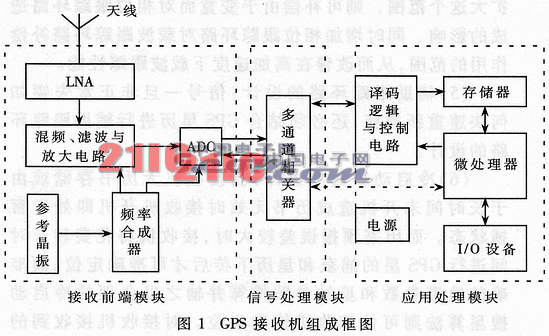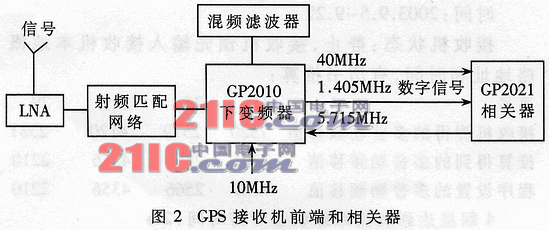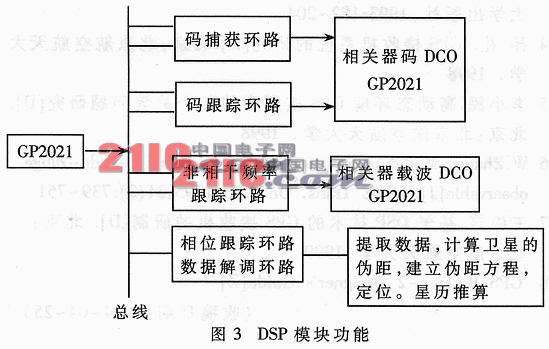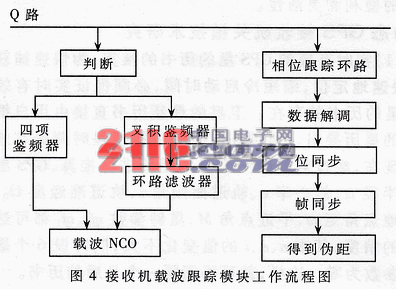Abstract: Under high dynamic conditions, combined with GEC's twelve-channel correlator GP2021, the structural design of the CPS receiver and the key technologies involved in the development of the high dynamic CPS receiver and the functions of the DSP in the receiver are discussed.
GPS is a high-precision global satellite positioning and navigation system established by the United States. It has a wide range of applications in land, ocean, aviation and aerospace. The high dynamic GPS receiver can be used in many occasions such as missiles, satellites, and aircraft navigation. However, because the high dynamic GPS receiver involves sensitive fields such as military industry, foreign related technologies or products are blocked to China. The core solution technology is also rarely seen in various literatures, and related technologies must be independently developed.
The real-time dynamic performance, positioning accuracy and richness of functions of the GPS receiver are closely related to the performance of the CPU selected. A receiver with a large dynamic range has a large amount of real-time calculations and a high refresh rate, which places higher requirements on the microprocessor, that is, the receiver should have a higher digital signal processing capability. The DSP chip has software and hardware resources suitable for digital signal processing. It has fast calculation speed, convenient interface, convenient programming, good stability, high precision, easy integration, and can be used for complex digital signal processing algorithms. Therefore, my GPS receiver uses a DSP chip as the central processor. On this basis, a series of algorithms, such as GPS / INS combined algorithm and anti-multipath algorithm and the design of a new carrier tracking loop, using the original pseudorange and pseudorange change rate of the receiver to improve the receiver's resistance Interference and dynamic performance and positioning accuracy. 
1 Structural design of the receiver
GPS receivers that use related receiving technologies can generally be divided into three functional modules: a radio frequency front-end module, a signal processing module, and an application processing module, as shown in Figure 1. The composition of the highly dynamic GPS receiver is similar to it, the key is that the signal processing module has a fast acquisition function and a large acquisition and tracking bandwidth.
The main function of the signal processing module is to capture, track, despread, demodulate, etc. the signal, and extract observation and navigation data. The despreading of GPS spread-spectrum signals is generally done by the relevant receiving technology, and the core of the signal processing module is the correlator. Multi-channel receivers generally use multi-channel correlators to track 4 or more satellite signals in real time.
Taking GP2010 and GP2021 chipsets as the receiving front end and correlator, GP2021 is composed of time base generating circuit, address decoder, status register and 12-channel independent tracking module. Each independent tracking module includes carrier DCO, code DCO, correlator and corresponding carrier whole-cycle counter, code phase and epoch counter, etc. The correlator also provides a 5.714MHz clock to GP2010, under-sampling the 4.309MHz signal of GP2010 to obtain an intermediate frequency digital signal of 1.405MHz. GP2010 outputs an intermediate frequency signal with a center frequency of 1.405MHz to GP2021. The GPS receiver front end and correlator are shown in Figure 2.
According to DSP chip operation speed, price, software and hardware resources, calculation accuracy, development tools, power consumption and other factors, the 32-bit DSP chip TMS320VC33 of TI Company is used as the central processor for GPS signal processing and positioning solution. The operation speed is 75MIPS, the single instruction cycle is 13ns, and the built-in 1.1Mbit RAM is manufactured by 0.18μm CMOS process.
DSP functions include signal collection processing, GP2021 hardware control, phase tracking and navigation data demodulation loop, GPS navigation message extraction, message estimation, navigation positioning solution, etc. [1] (see Figure 3). 
The signal collection process mainly completes the correlation integral values ​​of the quadrature, in-phase lead and lag channels input from the correlator, and realizes the functions of judgment and filtering in the process of code ring and carrier loop acquisition and tracking according to these integral values ​​[2].
GP2021 hardware control mainly completes the closed control process of code loop and carrier loop. The values ​​in the code DCO and carrier DCO of the GP2021 are dynamically adjusted according to the control quantities of the phase tracking loop, code loop, and carrier loop output to realize data demodulation.
The phase tracking and navigation data demodulation loop is the last link of the carrier tracking loop, which implements carrier phase extraction and data demodulation.
The receiver makes full use of the functions of the DSP processor and concentrates the above software on a single DSP processor. The high-speed computing performance of the DSP chip softens some hardware functions, greatly reducing the size of the receiver and enhancing the flexibility of the system.
In code and carrier tracking loops, digital filters are used in many places. Because the calculation accuracy of TMS320VC33 is very high, a filter with a very steep amplitude-frequency characteristic can be realized, and a filter with a narrow bandwidth is completed. In addition, DSP is only affected by quantization error and limited word length in the process of digital signal processing, and does not introduce other noise during the process, and has a higher signal-to-noise ratio. These are exactly what the author needs to track the loop and the frequency ramp signal. At the same time, using DSP software programming to achieve digital filtering, only need to modify a few design parameters in the programming process, you can flexibly and easily implement filters with different performance, thereby changing the loop characteristics of the tracking loop, for loop debugging Comes great convenience and flexibility.
2 Research on key technologies of dynamic GPS receiver
(1) Real-time and effective calculation of the almanac of GPS stars: In order to quickly capture signals, quickly locate, and shorten the cold start time, it is necessary to ensure the existence of real-time and effective GPS almanacs. The latest almanac of the satellite is directly derived by the user based on the earlier ephemeris, and extrapolated to obtain the effective data of the time of cold star search. Now, after calculating the ephemeris separated by one month, the GPS satellite orbit long radius α, eccentricity e, orbital inclination angle i, orbit quasi-longitude Ω0, orbital perigee angular moment ω, mean anomaly point angle M, star clock parameter af0 , Af1 can reach considerable accuracy, in which the value of a, e, i does not change much, and set 6 perturbation correction parameters to zero. In this way, you can get the almanac one month later. 
time t1
af0 =: 0.596651807427D-04 af1 = 0.579802872380D-11
t1 + 30 days
af0 = 0.724918209016D-04 af1 = 0.477484718431D-11
t1 + 30-day calculation result
afo = 0.7237169739D-04 af1 = 0.4706628D-11
t1 time t1 + 30 days time
Ωt1 = -2.09716567564 Ω0t2 = -2.72117917258
ωt1 = -1.71643691820 ωt2 = -1.67529031669
Mot1 = 3.008373107049 Mot2 = -2.08799859062
From toe1, the ephemeris at time can be calculated toe2 ephemeris
It is calculated that Ω1ot2 = -2.720653, ωt2 = -1.666083,
Mlot2 = -2. 085210
(2) Research on the impact of clock characteristics on the dynamic performance of high dynamic receivers: clock characteristics (frequency drift and aging rate) have a greater impact on the dynamic performance of high dynamic receivers, and must be considered in high dynamic receivers and Try to eliminate it. Among them, the elimination of frequency drift can shorten the cold start time by about 60s.
(3) Research on the carrier tracking loop under high acceleration: In order to detect highly dynamic GPS signals, it is necessary to design a code ring and carrier loop acquisition and tracking digital system. When using a serial search method that simultaneously performs a two-dimensional search of the signal in the time domain (code phase) and frequency domain (Doppler frequency shift) to successively approximate the carrier Doppler frequency shift, under high dynamics, since The code acquisition is performed in frequency bands. The carrier tracking loop provides speed assistance to the code tracking loop, and because the code tracking is performed within a frequency error range of 500 Hz, the frequency change rate caused by high acceleration within a certain range The acquisition and tracking have little effect, and the loop loss of lock begins with the carrier tracking loop. At the same time, the high speed within a certain range only affects the number of frequency bands involved in frequency acquisition and has little effect on frequency tracking. Therefore, under high dynamics, it is of great significance to solve the problem of carrier tracking under high acceleration in code tracking and carrier acquisition and tracking of CPS signals. Need to design a carrier tracking related algorithm with a large dynamic range. The algorithm should also take into account the loop operating characteristics under high acceleration and high acceleration environments.
Now, the author has designed a carrier tracking loop with a large dynamic range and used it in the receiver, but the specific indicators of the loop are being tested. The working flow chart of the receiver carrier tracking module is shown in Figure 4.
(4) Improvement of the phase tracking loop of the original low dynamic receiver. The four-term frequency discriminator and cross-product frequency discriminator realize accurate frequency tracking. The phase tracking and navigation data demodulation loop is the last link of the carrier tracking loop, which implements carrier phase extraction and data demodulation. Only the code lock and carrier lock can be achieved when the cross product discriminator is reached. Bit synchronization and frame synchronization states can only be achieved after the phase tracking and navigation data demodulation loops are working correctly. Only after frame synchronization (that is, data can be demodulated correctly and frame synchronization) can the receiver get the correct pseudorange. After that, the navigation and positioning equations are established and accurately positioned. Therefore, if the phase tracking and navigation data demodulation loops do not work properly, the receiver will not be able to locate. Properly expanding the equivalent noise bandwidth BLF of the carrier tracking loop reduces the tracking accuracy. Various errors generated by the carrier tracking loop will be reflected in the phase tracking loop, but the acquisition time is shortened and the dynamic range of the phase-locked loop will be improved; at the same time, For the phase tracking loop, due to its limited effective range of linear traction, if this range can be expanded, the effect of the widening on the phase tracking loop can be compensated, and the compensation effect of the phase tracking loop on the carrier tracking loop is increased at the same time. The range, thereby improving the wave tracking performance at high acceleration download waves. 
(5) Design of the auxiliary tracking loop: how to quickly reacquire the signal once the lock is abnormally lost, the design of the auxiliary tracking loop must also be combined with the GPS ephemeris.
(6) Design of cold start algorithm: when the receiver has no almanac storage or the almanac is invalid because it has not been turned on for a long time, the receiver is in a blind arrest state when it is turned on. When the almanac forecast error is large, the receiver will take a long time to acquire the GPS star and download the ephemeris before it can be accurately located. The accurate orbit parameter and star clock parameter estimation, supplemented by a reasonable cold start star search algorithm, can enable the receiver to quickly locate. The carrier Doppler frequency shift of the GPS signal received by the receiver is analyzed and the calculation formula of each component is given. At the same time, the influence of each component on the receiver star acquisition occupancy time is analyzed according to the experimental results. A new cold start algorithm is proposed by eliminating the clock frequency drift of the receiver and supplemented by effective almanac calculation, which greatly shortens the cold start time of the highly dynamic GPS receiver. When the receiver's local rough address and time are input in advance to the stationary receiver, the cold start time is shortened to less than 25s.
3 Experiment
Time: 2003.9.5 ~ 9.27
Receiver status: stationary, the receiver enters the receiver's local rough address and time in advance, and the almanac estimates:
Asterisk 15 26 21 29
The Doppler shift measured by the receiver 7320 2579 4120 2381
The calculated Doppler shift value 7201 2566 4356 2210
Program set Doppler frequency shift value 7201 2566 4356 2210
Time required for 4 stars to reach carrier tracking state: 21s
Cold start time without considering receiver clock drift: 82s
Consider the cold start time after the receiver clock drifts: 21s
Ejector Connector,Plug Row Connector,Ejector Header Socket,Ejector Header Connector
Dongguan ZhiChuangXing Electronics Co., LTD , https://www.zcxelectronics.com